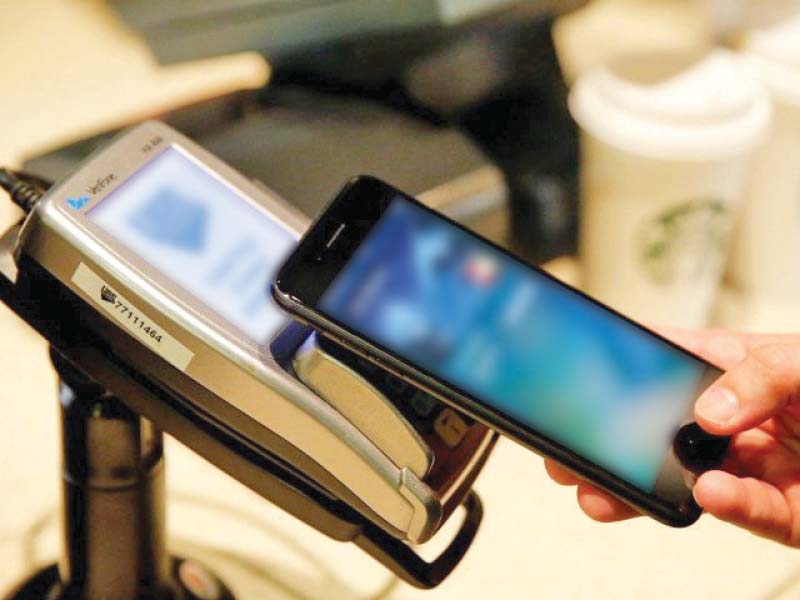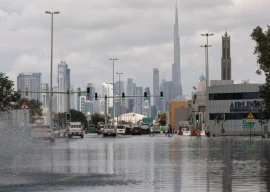
Safeer Khan, a tea vendor in Islamabad who mostly serves tea to officers of a renowned telecommunication company, was encouraged by his customers to adopt e-wallet as consumers most of the time did not carry change with them. Consequently, Khan went for the digital payment system and opened an account with a domestic company.
When he started receiving payments, the branchless banking services provider, Easypaisa, found his monthly income enough for applying for a loan.
He expeditiously applied for the loan as he needed to purchase more goods to run his shop for a longer time period each day to cater to the demand from customers who would visit his outlet after the end of their shifts.
Pakistan unveils strategy to move to cashless economy
The 42-year-old Khan lives in Rawalpindi and supports a family of seven including four children. He earns roughly Rs1,200 per day.
Earlier, the biggest hurdle faced by Khan was access to credit. He started the tea business from his savings from a daily-wage job coupled with borrowing from friends and family members.
However, the borrowed amount turned out to be enough only for setting up a small business and not for its expansion. He approached many banks for acquiring loan but each time he found the requirements confusing and time-consuming. Moreover, he was perturbed as well about the consequences if he was unable to repay such a loan.
Later, he discovered about Easypaisa loans after receiving an SMS from the service provider. Initially, he borrowed Rs1,000 and following timely repayment of successive loans, he became eligible to take a loan of Rs7,100.
Khan is just one successful example of financial inclusion. In fact, 75% of the population in Pakistan is outside of the formal financial system and only 25% have a bank account or under the digital payment mechanism.
Digital payment in Pakistan is still in its infancy but it has immense potential to revolutionise the payments infrastructure in the country. More than a dozen digital payment companies have received licences from the State Bank of Pakistan to operate in the country.
Love of cash hinders India's move to digital economy
“To unlock the $36-billion digital finance potential of Pakistan, it needs a high-level commitment, faster payment gateways, lower costs and fast-track licensing for the fintech sector and digitisation of government payments,” said World Bank Country Director for Pakistan Patchamuthu Illangovan in a tweet last month.
“Widespread use of digital payments in Pakistan can give a 7% boost to the gross domestic product (GDP) while creating four million jobs, mobilising over $250 billion in deposits and formalising large parts of the cash economy,” he said. “Only 18% of the population utilises digital payments in Pakistan right now.”
On average, according to him, a Pakistani makes only one digital transaction per year compared to five in India and seven in Indonesia. He, however, voiced hope that Pakistan could accelerate digital payments and leapfrog its peers.
A real-time retail payment gateway coupled with a booming fintech sector could accelerate the use of digital payments in Pakistan to at least 50% of the population by 2020, he said.
Micro-payments
“Karandaaz is working with the State Bank of Pakistan on micro-payment gateways, which will make payments from one platform to another easier and quicker,” said Karandaaz CEO Ali Sarfraz while talking to The Express Tribune.
Current payment systems settle payments within 24 hours after a transaction is made, although the host receives the payment instantly. Real-time payment systems will complete this process in seconds, which will lead to a manifold rise in the volume of small transactions. “Right now, this technology exists in only 10 to 12 countries,” said Sarfraz.
The current mechanism demands several details of a transaction such as the bank account number, name of the bank in a particular format, etc. If somebody wants to send an amount from a bank to a micro-payment gateway, he is required to use the Inter Bank Fund Transfer (IBFT) system, which is a lengthy and complicated process.
“We are introducing a new function called directory function,” said the CEO of Karandaaz – a not-for-profit company that promotes access to finance for the SMEs. “In this function, the mobile number, CNIC number and the name will be tagged with the account number.”
These particulars would be linked with the account number depending on SBP regulations, and the sender would not need to remember the account number, he said.
The new system will not only connect banks but also other institutions and even pension could be received through it. At present, pensions are first sent by the government to National Bank of Pakistan, which uploads details on its system and then transfers the amount to five other banks, which disburse it to the beneficiaries.
Terming it a lengthy process, the Karandaaz CEO said the new payment gateway would allow the pension-issuing institution to skip these steps and send the amount directly to the pensioners’ accounts. “The current system cannot achieve this because of its limited capabilities,” he said.
In addition to this, fintechs can also be connected to this system and offer their services.
“Right now, they either have to receive a licence or approach a bank for partnership,” he said. The system will allow them to offer their services standalone without going through cumbersome processes.
This speedy payment transfer system, which can handle low-value transactions, will solve liquidity problems of merchants as they will receive payments in real time.
“The micro-payment gateway will have the capacity to process payments in seconds which will help improve mobile phone financial services,” said Sarfraz. “The State Bank is working on many other options to facilitate e-commerce infrastructure in the country.”
Though digital payments are seldom used in the country, still dozens of new players like NayaPay, ForeePay and others are entering the market.
“For new fintechs, it is a good time to invest and offer new services which the existing players are not offering currently,” said the Karandaaz CEO. “The new companies only have to keep one thing in mind, that this is a long-term strategy which will not bear fruit in just one or two years.”
Awareness
“Many digital payment solutions have entered Pakistan and now awareness of digital payments is needed,” said Muhammad Aslam Hayat of Telenor Microfinance Bank while talking to The Express Tribune.
“We need to motivate people, who prefer cash transactions, to opt for applications like e-wallet, which offer a variety of options to the common man with a user-friendly interface especially designed to facilitate the illiterate,” he said.
He was of the view that companies needed to gain confidence of such people and for that they should offer incentives like discounts or cash-back to the customers using their application for payments.
After motivating people to become part of the mobile payment system, the companies needed to engage them by offering the option to pay on retail stores also, because at present only high-end shops offered the payment option, he said.
“About 50% of Pakistanis are illiterate which means the application has to be so simple and easy to use so that everyone can understand,” he said. “To attract a person who prefers cash payment towards a digital payment system, we need to make it so efficient that payment could be made in five seconds similar to scanning a QR code and typing the amount, otherwise people will be discouraged.”
That was the real target of the new digital payment system, otherwise only a few people would adopt it like the credit card mechanism, which was utilised by a particular class with high income, he added.
On the other hand, Hayat stressed that digital payment companies should team up with the government and develop an ecosystem for digital payment such that even bakeries, barber shops, betel leaf and tuck shops were able to use it.
“Currently, digital payment options are available at high-end restaurants and boutiques only, which is not enough,” he said. “Common people are familiar with the digital payment system for remittances inside the country like Easypaisa, however, they do not use it for retail payments.”
QR codes
QR code, a machine-readable optical label that contains information about an item, is an integral part of the digital payment system which allows customers to pay through their mobile phones.
“Many digital payment solutions are offering this feature but the problem is whether the merchant motivates customers to pay through it or not,” said Karandaaz CEO Ali Sarfraz. “If the shopkeeper urges the customer to pay through the QR code, he will hesitate a little bit but will eventually pay.”
He asked why merchants were not adopting the QR code facility? Customers were just one half of the electronic payment system and the other half were merchants but no one considered them, he said.
Currently, most merchants charge extra 2.5% while accepting payments through credit cards.
“Similar to the customers, there should be some incentives for the merchants as well for introducing QR codes on their shops,” he said. “It is easy for them to deal in cash because they receive it instantly.”
“An important benefit of the QR code is its security,” he pointed out. The amount paid goes directly to the bank without hassle but for that a shopkeeper needs a merchant account for which KYC (Know Your Customer) is required, which is impossible if a merchant does not own a documented shop.
“Therefore, there are some regulatory challenges while others are technological and taxation issues,” he said. “On the other hand, merchants think tax authorities will harass them if they use bank channels for payments.”
Rethinking payments system
“This is called tragedy of the commons,” remarked Sarfraz. “Everyone is waiting for others to install QR codes and give merchants the initial benefits.”
Payments through QR codes mean that merchants would not have liquidity at hand, ie cash.
“A merchant may accept the QR code payment but his supplier may demand cash which he would not have, hence digitisation is needed in the whole value chain,” he stressed.
Another important factor is that companies push consumers to adopt QR code payments but they fail to push merchants.
The State Bank has invited stakeholders to introduce a unified QR code payment system as it requires dedicated infrastructure, he said. One solution could be a joint fund created by all banks and digital payment systems for investment in QR codes similar to the Universal Services Fund (USF), which receives contributions (1.5% of adjusted revenues) from telecom operators for developing telecom infrastructure in far-flung areas.
Another potential proposal discussed with the SBP is that it should design one QR code for all market players.
Until recently, opening a bank account was a nightmare in Pakistan – easy company account is still a distant dream in the country — though the SBP and the other government institutions have initiated several reforms in this regard which lifted Pakistan’s ranking in the World Bank’s Ease of Doing Business Index. In this regard, the SBP is promoting digital payment systems like Easypaisa and its customers have been allowed to open level-1 and level-2 accounts but both of them have their own limitations.
the writer is a staff correspondent
Published in The Express Tribune, November 25th, 2019.
Like Business on Facebook, follow @TribuneBiz on Twitter to stay informed and join in the conversation.










































COMMENTS
Comments are moderated and generally will be posted if they are on-topic and not abusive.
For more information, please see our Comments FAQ